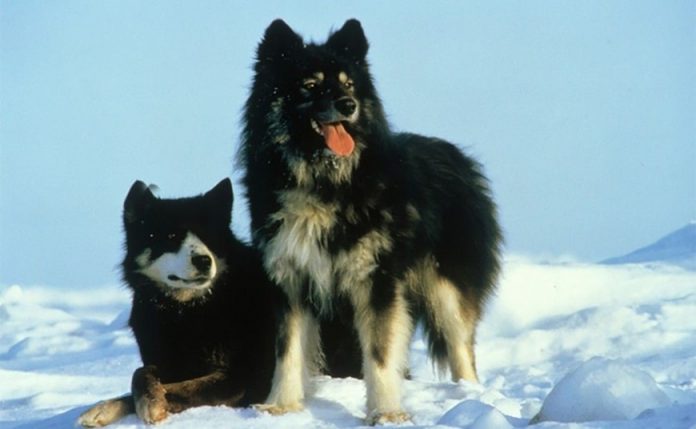
Have you heard about the tale of Taro and Jiro, the heroic Huskies from Japan? Their stories are worth revisiting because they serve as a testament to the strength of their breed, the Sakhalin Husky. In today’s post, let’s get to know more about their breedand the reasons why they are nearing extinction.
History
The Sakhalin Husky originated in the Sea of Okhotsk, the northernmost island of Japan almost reaching Russia’s largest island, Sakhalin. It is also called Karafuto-ken. Karafuto is the Japanese term for Sakhalin while ken denotes “dog.”
When Japan attempted to govern Sakhalin during the 1900s, the dogs were taken to Hokkaido where they were trained to be pack animals and sled dogs. Like the majority of Japanese breeds, their number diminished during the Second World War. It is believed that the only authentic Sakhalin Huskies are the ones left in Russia’s largest island.
Recognition
Sakhalin Huskies did not receive an official approval as a standard breed from major kennel clubs. Despite that, they became a subject of books and movies. Nankyoku Monogatari or the “South Pole Story,” a Japanese film about the Taro and JiroSakhalins, is the basis of the 2006 Disney movie Eight Below.
Although they were referenced in the Disney film, this takes its plot from the Japanese expedition in the 1950s. In the 2006 movie, they used Alaskan Malamutes and Siberian Huskies to provide a fictional version of the Sakhalin’s occurrence.
Based on the plot, the Japanese Antarctic Surveying Teamwent on an expedition in 1958, leaving 15 Sakhalin Huskies chained up at the Showa Base. The extreme weather conditions and an unexpected storm stopped them from returning to the base. The dogs were left behind with nothing but food to last them for a week.
They assumed a relief team would arrive within a few days but due to the extreme weather conditions, the team never made it to the outpost until after 11 months later. When the team returned, they were expecting to see all of the dogs dead but they were astounded to see Taro and Jiro alive. The two dogs managed to live for almost a year despite the harsh weather conditions and without a human guiding them.
A professor from Kyushu University believed the dogs ate penguins, wastes of seals, seabirds, and even fishtrapped in the ice because the bodies of other Sakhalin dogs were intact and did not look like they were cannibalized.
Out of all 15 dogs, only eight managed to get away from their chains while the rest died of hunger. The remaining dogs journeyed in the wild but only the youngest ones, Taro and Jiro survived. Jakku, along with Taro and Jiro’s father Kuma were out of sight while the other four deceased.
Appearance
Sakhalin Huskies are sometimes mistaken for Siberian Huskies and Akita because of their spitz look and thick coat. They look like giant teddy bears and come in four basic colors: black, cream, russet, and biscuit. They have a dense coat that is comparable to that of the Greenland Dog that originated in Siberia.
A grown-up Sakhalin would normally weigh anywhere from 30 to 40 kilograms and stand 56 to 66 cm at the withers. They are noticeably twice heavier and taller than an adult Siberian Husky but closer to the average height and weight of Akitas. There were suspicions that they are among the ancestors of the Akita dog, which also originated in the northernmost region of Japan.
Based on the descriptions provided for the 15 Sakhalin Huskies, they do not share uniform characteristics. Their unclear standard is also the reason why they are not recognized by kennel clubs. Taro, for instance, sported a black coat while his brother Jiro was dark brown and had white markings all the way from his chest down to his paws.
Pesu, a five-year-old Sikhalin male allegedly looked like a Belgian Tervuren, a herding breed with a black mask and thick double coat. Jakku, a four-year-old Sikhalin male, was said to be comparable to a black and white border collie with a long top coat.
Their father, Kuma from Furen, looked more like Jiro because of the white ripple on his chest. However, he and Taro shared the same coat color. Kuma was among the 15 dogs left by the Japanese team in 1958 but he disappeared in the wild while trying to survive with seven other remaining dogs.
Temperament
Many dog experts believe that if Sakhalin Huskies were still alive, they would be some of the smartest and friendliest dogs in town. What’s great about them is they are not as stubborn as the Siberian Husky.
Taro and Jiro’s survival skills just proved that these dogs have an independent nature. If alive, they would be as friendly as the Siberian Husky, a breed known for being good around kids and other pets. Their unique and lovable traits are just some of the reasons why there are efforts to save them from extinction.
Exercise Needs
Like Huskies, these dogs could run for miles despite the harsh weather. Their powerful muscles and bones make it possible for them to run through the snow. They can conquer a distance of 150 kilometers per day regardless if their sled is empty or loaded.
They are also believed to be stronger than modern-day Huskies, which is not questionable because of their massive built. Based on pictures, they are twice larger and their coats are clearly denser and thicker than modern-day spitz dogs.
If only they are around, they will not be suitable for novice pet parents. These dogs obviously require lots of physical stimulation, making them suitable for people with active lifestyle if they were alive to be domesticated dogs.
Sakhalin Dogs Revival
In 2016, news surfaced that Sakhalin Oblast’s former governor Oleg Kozhemyako supported the planned revival of the breed. He visited Oleg Seliverstov, an enthusiastic breeder who was reported to have seven Sakhalin Huskies at that time.
Sergey Lyubykh, the last remaining breeder of the Sakhalins, reportedly said before his death that it will be difficult to continue breeding these dogs because there were not enough living specimens to allow genetic diversity.
On the contrary, Oleg Seliverstov revealed that before Lyubykh died, he turned over his pets to him. He reportedly asked Seliverstov to not the Sakhalin breed totally disappear. In an effort to save the unique breed from extinction, there has been help given to Seliverstov like food for dogs.
Conclusion
While the future of Sakhalin Huskies is unclear, the story of Taro and Jiro’s survival will forever be remembered. In fact, these dogs are now considered national heroes. It just goes to show that dogs are clever by nature and they can use their intelligence to survive even without human help. When they died, their embalmed bodies were put on display in museums. There were also three monuments of these dogs across Japan.




















